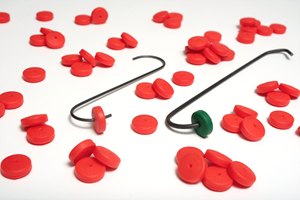Conveying Long Parts Horizontally
Industrial finishing line consultant Dan Davitz offers advice for designing racking for navigating long parts along a monorail conveyor.

Davitz
Q. Do you have advice for how to best hang long parts on a conveyor?
Designing a rack to hang long parts horizontally on a monorail conveyor requires two main elements. First, a special load bar, and second, two vertical uprights which hang from the load bar, designed to hold the parts.
When a conveyor makes turns, the distance between the pendants actually becomes shorter. Consequently, when holding a long part horizontally between two conveyor pendants, as the conveyor goes into a turn, the two hanging points move closer together squeezing the part between them resulting in excessive stress being placed on the part and the hooks holding it. Ultimately, either the part or the hooks give way to the power of the conveyor.
The following steps describe how to design the two elements necessary to resolve this problem.
Step One – A Special Load Bar
First, a specially designed load bar, usually a little longer than the parts themselves and attached horizontally underneath the conveyor, is used to isolate the painted parts from the shortened distance taking place between the conveyor pendants around turns on the conveyor. Two vertical uprights, with hooks to hold the actual parts horizontally between them, will hang from the load bar.
This special load bar is designed with one leading attachment at a fixed location on the load bar and attached to a conveyor pendant, and one trailing 4-wheel trolley that rolls in-and-out along the load bar when turns are encountered on the conveyor. The top of the 4-wheel trolley installed on the load bar, is then attached to a trailing conveyor pendant. Both the leading and trailing attachments mounted on the load bar, must be able to rotate and pivot where they attach to the conveyor. In addition, the load bar must be installed far enough below the conveyor not to touch it on the angled approach to all inclines, or, on the departure angles from any declines.
Step Two - Vertical Uprights
The next step is to design the vertical uprights to actually hold the painted parts themselves. They must remain vertical at all times, even on the inclines and declines when the rack pivots and becomes a parallelogram. Therefore, the attachments for the vertical uprights to the load bar must be controlled pivots in both directions. For ease in cleaning and storage, the vertical uprights should be easily installed and removed from the load bar.
Depending on the profile of the parts, the hooks attached to the vertical uprights may be designed in any number of ways in order to hold the parts on, or close to the ends, or on the inside or outside of the parts. The important thing to consider in the hook design is that as the vertical uprights pivot on the load bar as it follows the inclines and declines on the conveyor, so the hooks must also pivot on the uprights, or pivot on the parts. Also note that if the hook does not hold on to the part in order to maintain the distance between the vertical uprights, a retaining rod must be used to hold them together particularly on the inclines and declines.
Conclusion
If you have a finishing line with a monorail conveyor, and have struggled with how to paint long parts horizontally, with a little effort and these steps, you should have both confidence and success to make it happen! However, if a lack of time or personnel finds you unable to make this or other improvements to your line, a rack consultant can provide the design and knowledge to get your finishing line running as smoothly and efficiently as possible.
Dan Davitz is an Industrial Finishing Line Consultant with over 30 years’ experience internationally, specializing in rack design.
He is Founder and Independent Consultant at Prism Strategy & Design, LLC
Info@PrismStrategyAndDesign.com
Related Content
FABTECH 2024 Heads to Orlando
CCAI’s FINISHING Pavilion and Conference continues to grow at FABTECH, offering insights and innovations covering all aspects of industrial surface finishing.
Read MoreTroubleshooting 5 Common Racking Problems for Platers
Being aware of usual issues that might occur during the plating process will prepare platers by helping them know how to avoid them all together or how to fix them if they happen.
Read MoreCFS Unveils New Hook Locks Parts Racking Solution
New product from Custom Fabricating & Supplies (CFS) prevents part loss during coating processes.
Read MoreFilm Thickness Control
Have a powder coating job that requires precise film thickness control? Products Finishing columnist Rodger Talbert offers advice controlling the variables that can impact your success.
Read MoreRead Next
Building a Custom Rack
A rack is a rack is a rack. Not so at Cornerstone Rack and Tooling, where each rack is specifically designed and engineered for its application...
Read MoreHow to Design an Effective Racking System
Well-designed racking is an important part of any finishing operation. Richard Lang, who handles technical sales for EPSI’s racking and hanging division, offers insights for designing an effective racking system.
Read More







.jpg;maxWidth=300;quality=90)











